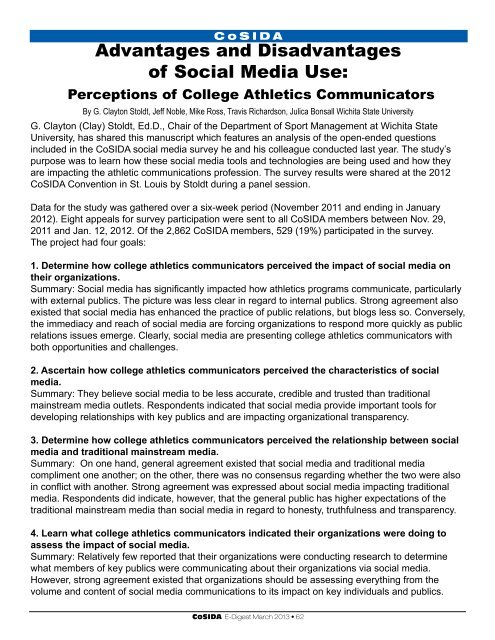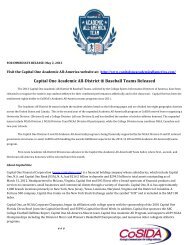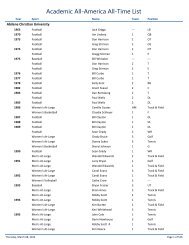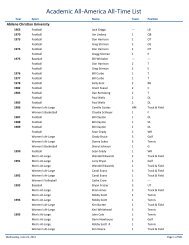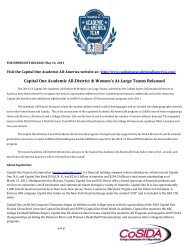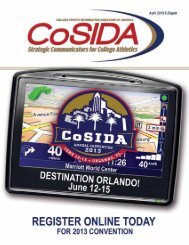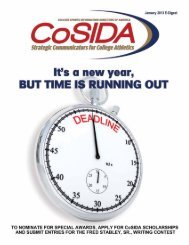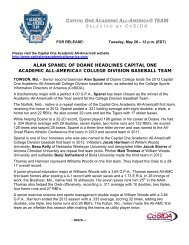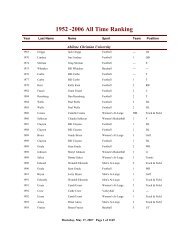CoSIDA E-Digest March 2013 • 1
CoSIDA E-Digest March 2013 • 1
CoSIDA E-Digest March 2013 • 1
You also want an ePaper? Increase the reach of your titles
YUMPU automatically turns print PDFs into web optimized ePapers that Google loves.
<strong>CoSIDA</strong><br />
Advantages and Disadvantages<br />
of Social Media Use:<br />
Perceptions of College Athletics Communicators<br />
By G. Clayton Stoldt, Jeff Noble, Mike Ross, Travis Richardson, Julica Bonsall Wichita State University<br />
G. Clayton (Clay) Stoldt, Ed.D., Chair of the Department of Sport Management at Wichita State<br />
University, has shared this manuscript which features an analysis of the open-ended questions<br />
included in the <strong>CoSIDA</strong> social media survey he and his colleague conducted last year. The study’s<br />
purpose was to learn how these social media tools and technologies are being used and how they<br />
are impacting the athletic communications profession. The survey results were shared at the 2012<br />
<strong>CoSIDA</strong> Convention in St. Louis by Stoldt during a panel session.<br />
Data for the study was gathered over a six-week period (November 2011 and ending in January<br />
2012). Eight appeals for survey participation were sent to all <strong>CoSIDA</strong> members between Nov. 29,<br />
2011 and Jan. 12, 2012. Of the 2,862 <strong>CoSIDA</strong> members, 529 (19%) participated in the survey.<br />
The project had four goals:<br />
1. Determine how college athletics communicators perceived the impact of social media on<br />
their organizations.<br />
Summary: Social media has significantly impacted how athletics programs communicate, particularly<br />
with external publics. The picture was less clear in regard to internal publics. Strong agreement also<br />
existed that social media has enhanced the practice of public relations, but blogs less so. Conversely,<br />
the immediacy and reach of social media are forcing organizations to respond more quickly as public<br />
relations issues emerge. Clearly, social media are presenting college athletics communicators with<br />
both opportunities and challenges.<br />
2. Ascertain how college athletics communicators perceived the characteristics of social<br />
media.<br />
Summary: They believe social media to be less accurate, credible and trusted than traditional<br />
mainstream media outlets. Respondents indicated that social media provide important tools for<br />
developing relationships with key publics and are impacting organizational transparency.<br />
3. Determine how college athletics communicators perceived the relationship between social<br />
media and traditional mainstream media.<br />
Summary: On one hand, general agreement existed that social media and traditional media<br />
compliment one another; on the other, there was no consensus regarding whether the two were also<br />
in conflict with another. Strong agreement was expressed about social media impacting traditional<br />
media. Respondents did indicate, however, that the general public has higher expectations of the<br />
traditional mainstream media than social media in regard to honesty, truthfulness and transparency.<br />
4. Learn what college athletics communicators indicated their organizations were doing to<br />
assess the impact of social media.<br />
Summary: Relatively few reported that their organizations were conducting research to determine<br />
what members of key publics were communicating about their organizations via social media.<br />
However, strong agreement existed that organizations should be assessing everything from the<br />
volume and content of social media communications to its impact on key individuals and publics.<br />
<strong>CoSIDA</strong> E-<strong>Digest</strong> <strong>March</strong> <strong>2013</strong> <strong>•</strong> 62


